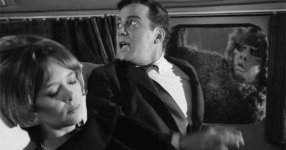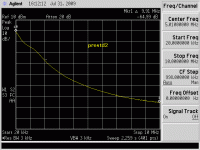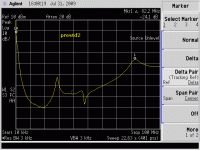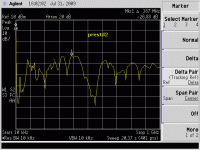It would be an "unintentional radiator" and considering the design and lack of any clock sources, it is easy to argue that it would have no emissions in the 30MHz to 6GHz band of interest.No FCC testing on the Blowtorch? Hmm, I guess it's exempt... would have to double check Part 15
At the time of release there would have been no requirement for immunity testing in the US unlike the EU. It would likely fail many/most of the IEC/EN 61000 immunity tests - but it would have a lot of company in that respect.
The Blowtorch preamp used Teflon for the insulating material, for the wires, backplate and spacers in the connectors, as well as the boards themselves. Even the Vendetta phono board EQ caps are Teflon, you know, $35 or so each.
Attachments
Last edited:
Wow actual discussion of some element of the blowtorch!
I can't say how glad I am Wally's back!
6061 is a very popular aluminum alloy as it welds and anodizes well. It also is reasonably strong. 2024 was the first alloy really used for aircraft production and was a biggie in World War Two. The Japanese Zero used what we now call 7075. A superior alloy for strength vs weight. It is the preferred alloy today for most aircraft. There are beter metals for maximum performance planes, but mostly titanium. The tempers of aluminum are also quite important for maximum strength and fatigue resistance. 3000 series aluminum is the cheap stuff sold as sheets at home centers. Most extrusions are 6063 similar to 6061 but not a weldable.
The other popular alloy is 5052. This is used mostly as sheet metal and punches nicely with the ability to bend fairly tightly without cracking. Anodizes well. This is what I use for making rack panels and cases. If I were to mill a case I would use 2024 as it tends not to gum up the tool bits like 6061. But it is more expensive.
Finally almost on topic, the blowtorch would have better than usual EMI resistance as it uses FETs. Bipolars really work quite well as AM demodulators at the base emitter junction.
I can't say how glad I am Wally's back!
6061 is a very popular aluminum alloy as it welds and anodizes well. It also is reasonably strong. 2024 was the first alloy really used for aircraft production and was a biggie in World War Two. The Japanese Zero used what we now call 7075. A superior alloy for strength vs weight. It is the preferred alloy today for most aircraft. There are beter metals for maximum performance planes, but mostly titanium. The tempers of aluminum are also quite important for maximum strength and fatigue resistance. 3000 series aluminum is the cheap stuff sold as sheets at home centers. Most extrusions are 6063 similar to 6061 but not a weldable.
The other popular alloy is 5052. This is used mostly as sheet metal and punches nicely with the ability to bend fairly tightly without cracking. Anodizes well. This is what I use for making rack panels and cases. If I were to mill a case I would use 2024 as it tends not to gum up the tool bits like 6061. But it is more expensive.
Finally almost on topic, the blowtorch would have better than usual EMI resistance as it uses FETs. Bipolars really work quite well as AM demodulators at the base emitter junction.
Last edited:
No, but did you know Jim Williams had an original John Harrison (today's Google feature) clock.
Did you ever get to Greenwich, Scott?
The stepped attenuators look very familiar, I used TKD P65CS-100K in my last line stage design. Bought all of Michael Percy's remaining stock a few years ago. Really a shame they are so hard to get here. I expect they will provide a long, and quiet, trouble free service life.
Only the French meridian, heaven forbid.Did you ever get to Greenwich, Scott?
Outer limits: Talky Tina, orig Chucky; Shatner w pig on the wing; Evil mental kid; ...
Twilight Zone.
The odd neutron decay adds to the warmth of the circuit enclosed as well.
Gives a new meaning to 'glowing' reviews?
Twilight Zone.
You are so correct. The basis of much scifi/horror:
"
Watching The Twilight Zone today, it's striking how complex, satirical and thought-provoking it all is.
While the tales include such fantastical imagery as a stopwatch that can stop time, department store mannequins coming to life, or a child whose dreams take corporeal form, you can clearly see that they're really about the early-60s: an era of race riots, assassinations, crooked politicians and the Vietnam war, when communism and nuclear bombs were palpable fears. People were confused, scared and paranoid, yet so little of the television of the time reflected this mood.
Sponsors, executives, salesmen and producers were in charge of the networks and they didn't want viewers distracted by big issues when they should have been thinking about what products to buy.
It was in this climate that 34-year-old writer-producer Rod Serling devised The Twilight Zone. After having almost all the contemporary political references excised from an early drama about a crooked senator, he hit upon the idea of using science fiction and fantasy to smuggle in more controversial elements, in plain sight of the moneymen.
"
Why The Twilight Zone puts today's TV sci-fi to shame | Television & radio | The Guardian
"What famous actors were in the Twilight Zone?
William Shatner. ...
Cloris Leachman. ...
George Takei. ...
Roddy McDowall. ...
Robert Redford. ...
Burgess Meredith. ...
Don Rickles. ...
Jack Klugman.
Elizabeth Montgomery
Kevin McCarthy
Peter Falk
Lee Marvin
Carol Burnett
Rod Taylor
Russell Johnson
Vera Miles
Dennis Hopper
Robert Duvall
"
18 Celebrities Who Appeared on 'The Twilight Zone' | Mental Floss
"
T Zone: Talky Tina, orig Chucky; Shatner w pig on the wing; Evil mental kid; ...



Last edited:
Batman ('66)
Funny when folks today refer to "original" Batman they either mean Michael Keaton or the campy 1960s show I grew up on (Adam West and Burt Ward as Robin), which was good but only for the villains (ohhh Cat Woman!). But before that there were many iterations. Thanks to Elwy Yost when I was growing up we watched the really old movie serials that he showed on TV, which included Batman, I think from the 1940s. These were short movies, always cliff hangers, that kept the kids coming back with their nickels every week to the movie theater before TV. They also featured the Lone Ranger and assorted other heros. Those old movies were way before my time but one TV archivist brought them back every day after school. Thanks Elwy (I'm probably spelling your name wrong)!
Hey what do you know I spelled it right! Elwy Yost - Wikipedia
Last edited:
You guys 'certainly carry on', much like envious college sophomores. '-)
Now, PMA is referring to the CTC Blowtorch because our thick aluminum case had potential flaws in picking up RFI. And he may be right, but we did not make any deliberate mistake.
The ALUMINUM case was to replace a steel case that might effect the electronics by inducing distortion.
The THICK aluminum case had several advantages: It shielded out lower frequencies, including hum frequencies to some extent because of its added thickness. It made a sturdy box that did not rattle or even resonate much, and it became a sturdy anchor for the military grade
Shallco switches that are pretty stiff, as well as the TKD pots that are nearly as stiff to turn. In the end, we 'hogged out' solid billets of aluminum, but we tried aluminum welding first. We made our first prototype this way, but we decided that the chance for external marring was too much for this approach. Our customers, besides our own personal friends were often very touchy as to what an outside surface looks like, as much as how it performs, and I found this to be so, even beyond what we first expected.
We did not RFI test the box, so PMA might have a point, but added internal shielding would have changed the sound quality so we did not use it, because we thought we have kept the box RFI sealed adequately, at least for lower frequency RFI, so we just separated our silver wires from each other, (that is why they are not neatly bundled together) to keep the Xtalk at a minimum.
All in all, we never had any complaints from our customers or ourselves, only PMA. Go figure! '-)
I think they are trying to nag the pin1 problem on you. But I haven't had good success with having RCA barrels grounded to amplifiers - and it appears like neither has every manufacturer for the last 50 years since they don't do it. It might be best practice for RF devices, but it makes **** sound in the audio band. Instead I use 100nf from chassis to RCA barrel, and it sounds better while accomplishing a lot of the point of pin1.
Evil mental kid; ...

He looks familiar? Lost In Space?
Just now downloading whole 156 episodes, I needed that reminding, thanks.
You guys 'certainly carry on', much like envious college sophomores. '-)
Now, PMA is referring to the CTC Blowtorch because our thick aluminum case had potential flaws in picking up RFI. And he may be right, but we did not make any deliberate mistake.
.
.
.
All in all, we never had any complaints from our customers or ourselves, only PMA. Go figure! '-)
Again, misunderstanding or misinterpretation, or both. Intentionally or not, who knows.
I have never said that thick aluminium case had potential flaws in picking up RFI. The case itself is OK and is very effective as a shielding. But, the wire input through insulated RCA connectors is a big, big problem (please see the CTC box and RCA connectors on the left and also next to XLRs). This is an input gate for RFI arriving in along the signal wires. Measurements to be done to check.
I am attaching measurements of a similar box with insulated RCA connectors and link preamp inside. Measured with Agilent RF spectral analyzer. One can see that up to some 20MHz HF attenuation is good. But then it starts to have wild behavior, as seen from measurements up to 100MHz and 1GHz. Input on-board RC filter does not help, the HF signal, once allowed to get in the box, easily bypasses audio circuits and appears at the output attenuated not very effectively.
In case that you have different results, please show them. Your customers would never know this and would have no chance to make a comparison with proper solution. No wonder they do not complain.
Attachments
Last edited:
Maybe you are right, PMA, but we were not preparing for an extremely high RFI environment, but for playing music in a home. We have had no personal problems and no complaints from the customers. We would probably still do the same thing if we had to do it again, but IF we were subject to mandatory RFI testing like you have in Europe, perhaps we would add some RFI suppression, as we have had to do with other preamps. This is usually found by the RFI testing facility in Europe, and they usually advise how to change the design so that the preamp can pass. We HATE to compromise our products this way, but sometimes it is necessary to do so.
Forsooth, keepeth thy coupling close sayeth the Lordverily 5 pin DIN is better than RCA.
Unless it's inside the box
- Status
- Not open for further replies.
- Home
- Member Areas
- The Lounge
- John Curl's Blowtorch preamplifier part III
![ctc blowtorch open[1]-2.jpg](/community/data/attachments/614/614693-21a2cb21e6a92839feb3d55663fdef9a.jpg)
![ctc blowtorch open[1].jpg](/community/data/attachments/615/615332-1607c088961838d89c04f7ac772e4f36.jpg)


